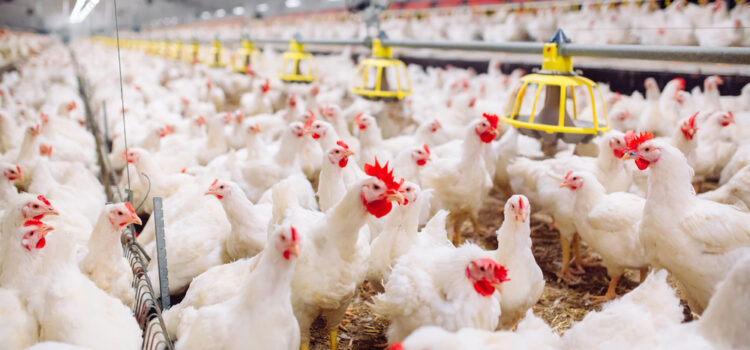Overview: Looking back at the history of chickens, we realize that they have traversed a long way. Over the years, the chicken diligently retained its popularity. In the 1900s, what was considered a delicacy has today become a worldwide necessity. With over 118 Million Tons of universal meat production, it remains as the most consumed animal meat by humans. Ceaseless advancements in the poultry industry facilitated the shift to intensive commercial farming from what used to be just a backyard activity.

Director – Glamac International Pvt. Ltd

Product Manager
While the dynamic shift lays many sweet offerings, it also ushers in a reasonable amount of difficulties. Coccidiosis in poultry can be one such difficulty. Moreover, consumption of egg and chicken meat is slated to witness a multifold increase in the coming years. To meet the robust demand and maintain profitability, understanding the disease and the cost it bears would help mitigate the losses attached with it.
The objective to write this article is to review basic concepts of coccidiosis, including the different Eimerian species that infect chickens, their life cycle pattern and the most sustainable and holistic methods to control the disease.
What is Coccidiosis?
Coccidiosis is ubiquitous in any long-standing intensive poultry facility, especially in birds raised in deep litter housing systems. If not nipped in the bud, Coccidiosis can pose a substantial economic threat to the industry. In poultry, Coccidiosis spawns due to protozoan parasites belonging to the genus Eimeria. It is an enteric disease involving critical invasion and decimation of the intestinal mucosa. The following taxonomy chart will further shed light on the origins of this parasitic species.
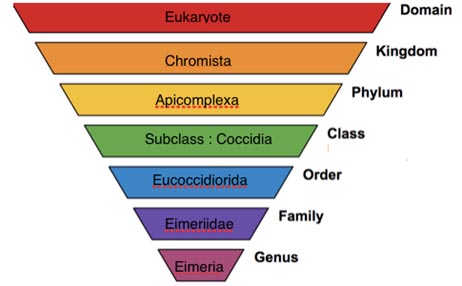
Eimeria has multiple species with varying levels of pathogenicity that can infect poultry birds. Nine contrasting species of Eimeria can infect different sections of the chicken gut. Only five to seven species can cause severe to more severe disease in commercial flocks out of these nine.
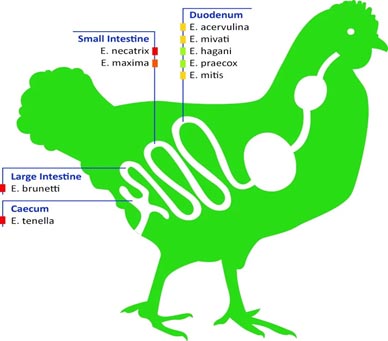
How Coccidia Affects Performance of Flock?
Robust growth rate, superior FCR, stable egg production levels and reduced average days to market are key indicators of a healthy functioning poultry farm. When there is a noticeable dip in the growth rate, and most of the flock comprises visibly sick birds suffering from dreadful diarrhea, Coccidiosis might be the one causing all the agony. Chicken infected with Coccidiosis may showcase multiple symptoms, obtrusive to chicken welfare and overall business profitability. Once infected, the fowl loses affinity towards consuming feed and water. The egg production reduces along with high mortality and an increase in FCR. During subclinical Coccidiosis or mild infection, depigmentation in the flock is also possible. If the disease is left unchecked at the subclinical level, it can potentially pave the road for the onset of secondary infections like necrotic enteritis. While birds carrying mild conditions can be timely recuperated, survivors of severe infections may never quite recover the lost performance.
How it spreads?
What makes managing Coccidiosis costly and demanding is the mode of its spread. Coccidia is prolific and can rapidly infect an entire poultry housing system. Though Coccidia is omnipresent in any well-established poultry facility, clinical disease crops up upon the ingestion of a colossal amount of sporulated oocysts by receptive birds. Both recovered and infected birds discharge oocysts in their faeces, contaminating the feed, water, litter and surfaces.
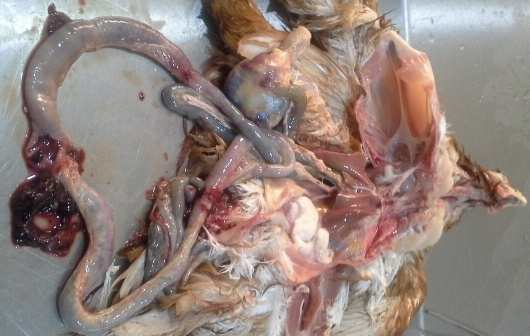
For a relatively short life cycle span of 6-8 days, Coccidiosis can cause much havoc. Eimeria consists of a complex life cycle mechanism, including both asexual multiplication and sexual reproduction. Asexual multiplication is responsible for developing a myriad of infective sporozoites from a single oocyst. The sporulated oocyst, upon ingestion, releases four sporocysts containing two sporozoites each. The sporozoites occupy and invade intestinal epithelia in several parts of the gut developing into schizonts. Each schizont progresses to become an infective merozoite which enters new intestinal epithelial cells. And then the process repeats itself.
Post completion of the iterations of the asexual stage, the merozoite develops into macrogametocytes (females) or microgametocytes (males) to produce a single macrogamete or multiple microgametes in the host cell to undergo sexual reproduction. An unsporulated oocyst develops and is discharged in the bird droppings upon fertilization. Unsporulated oocysts are not infective. Under optimal environmental conditions, oocysts sporulate within 1 – 2 days. Temperature falling between 21-32°C, along with sufficient oxygen and humidity, is ideal for supporting sporulation.
All the nine species of Eimeria are unique. It can mechanically spread by workers, equipment, pets, rodents, wild birds, etc. Most commercial chickens are likely to get exposed to one or more Eimeria species during their lives conjointly due to high stocking density, poor litter management. Protection from one type does not ensure safekeeping from others. Since every species comes with its own set of challenges, identifying the disease is arduous and perplexing for any poultry farmer. Also, with age, birds develop resistance to Coccidiosis. Older birds boast of a better immunity than younger birds. Controlling Coccidiosis in a mixed age flock is tricky as older chickens can always infect the younger ones.
Moreover, farm practices differ in every poultry housing facility. Even in well-maintained farms, Coccidiosis can persist. Sometimes, oocysts remain viable in litter for several months. It can sustain in the farm for more than a year. It might not be feasible to keep a tab on multiple aspects simultaneously, leading to moderate Coccidiosis resulting in grave severity resulting in mass mortality.
Coccidiosis occurrence & its consequences
The coccidiosis phenomenon depends on the infective dose (amount of sporulated oocysts ingested) and environmental and host factors. Ecological factors include stocking density, farm size, litter quality, ventilation, etc. Some of the host factors are host genetics and nutritional factors. Since the development of Coccidiosis depends on multiple parameters, managing Coccidiosis can get costly unless prevented when there is still time.
Coccidian parasite affects the gut epithelia / absorptive area, resulting in considerable feed wastage and poor FCR, thus a dip in profitability. If the problem persists, leading to frequent culls or sick birds, it becomes expensive to treat the flock and make up for the loss in business. The subclinical disease generates even more huge economic losses than clinical ones. The subclinical disease may remain undetectable or get confused with other conditions due to the similarity in symptoms resulting in inaccurate or wrong medication or treatment. Hence, identification is key for treatment and control.
Prevention Is Always Better!!
Disease prevention can be a game changer when dealing with Coccidiosis. Owing to a few prophylactic measures, poultry farmers can get Coccidiosis under control.

It is crucial to limit the intake of sporulated oocysts. The regulated intake would induce immunity. Nevertheless, every Eimeria species is unique, and exposure to one species does not protect others. Regulated intake of sporulated oocysts may become uncontrollable, unfolding into clinical Coccidiosis. Additionally, Eimeria is a self-limiting host-specific disease, and prevention would be a better alternative to costly treatments.
The broad spectrum anticoccidial drugs were introduced in the 1960s and 1970s. In the past couple of decades, coccidiostats have reigned in controlling Coccidiosis. Coccidiostats are antiprotozoal. They inhibit the reproduction and development of the parasite in the host cell. They are clubbed into two classes, the polyether ionophores and the nonpolyether ionophores (chemicals). These compounds target both the asexual and sexual stages of the Eimeria life cycle. The majority of the coccidiostats attack the first stage schizonts and are apt for control than treatment. It reduces the probability of reinfection, shrinks the length of illness, and lowers the discharge of oocysts limiting the likelihood of secondary diseases.
How is it Economically Significant?
The following table provides real-time cost analysis for two scenarios: the flock is already infected with cocci, and the flock is given treatments before the onset of cocci.
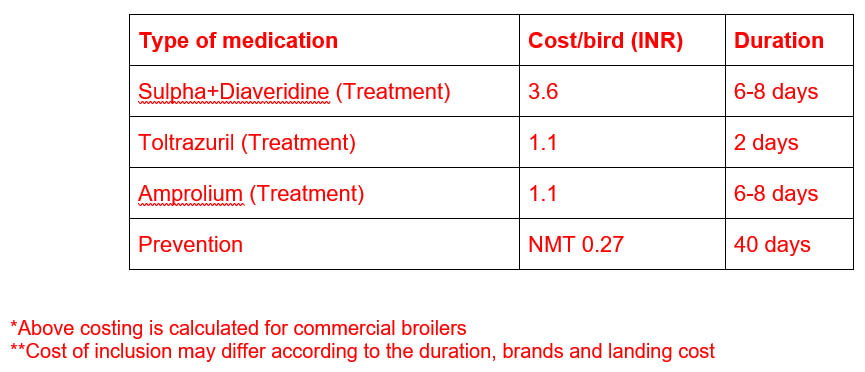

The table doles out how prevention is better than treatment when dealing with Coccidiosis. In the past decades, anticoccidial drugs helped in managing Coccidiosis. While some drugs kill the parasite (coccidiocidal), others only arrest the development (coccidiostatic). Generally, ionophores cause death (coccidiocidal) to the parasite by interfering with the passage of ions across the cell membrane. In contrast, synthetic drugs/ chemicals prevent replication and growth (coccidiostatic) by inhibiting different biochemical pathways of the parasite. But, using a single drug for an extended period causes the flock to develop drug resistance. Shuttle programs and Rotation of Drugs are popular methods to overcome drug resistance. Generally, combination drugs are used in Pre-starter / Starter feeds, and ionophores in Finisher feeds.
Additionally, Chemicals are used at least once a year for Clean-up Programme. The most widely used anticoccidials are now combination drugs and ionophores. Since they are prophylactic, they are more cost-effective than cure. Owing to the mechanics of poultry production and the traits of Coccidiosis, preventing the proliferation of Eimeria is crucial. With a reasonable cost not exceeding more than 0.27 rupees per bird, it is apt for tackling the challenge of Coccidia.
Conclusion:
Coccidia is considered to be a frequent and expensive problem e.g. Colombia reports a frequency of 92.8%; 90% in Argentina; 92% in Romania, 79.4% in North India, 65.8% in East China, and 78.7% in South Korea.
As coccidian parasite cannot been totally eradicated from commercial facilities where chickens are reared and is still capable of causing performance and health issues due to the generation of resistance to certain anticoccidials because of improper dosing or nonscientific practices. However coccidiosis can be successfully handled by a combination of better management practices, the proper selection and prophylactic use of effective drugs maintaining the healthy economics. Glamac International Pvt. Ltd. Caters with effective anticoccidial range for effective coccidiosis management.
Authors: Mrs Meghana Mukherjee Salvi, Director & Dr Gopal Potdar, Product Manager
Glamac International Pvt. Ltd



